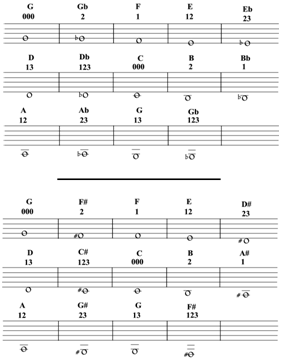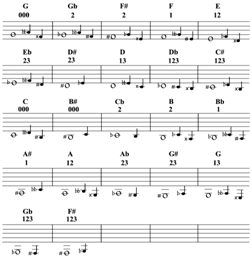8. Musical alphabet: The chromatic scale
“Papa, I am tired of playing the rhythm to Mary had a little lamb. I want to really play it with notes.”
“OK then, it is time to learn your notes.”
“O boy. Where do I start?”
Papa unfolded a piece of paper with notes on it.
“Here is what a scale of notes looks like.”
“They look like the alphabet.”
“You’re right. This is the alphabet of music. How many notes do you see in the top chart?”
Alexander counted the notes on the scale and said, “fourteen?”
“This is called the chromatic scale. And the last two notes on this chart (G and F#) are the same as the first two only an octave lower. So, there are really only twelve notes in the chromatic scale. These are all the notes you need to know to play any song.”
“Wow. What is the bottom chart of notes?”
“This the same chromatic scale, but some of the notes are different. There’s more than one way to designate a pitch7 with notes. The top chart uses flats, and the bottom chart uses sharps. They are just different ways to write the same chromatic scale.”
“What is a sharp and flat?”
“Let’s look at the note D.” Papa pointed to the D under the bottom staff line.
“Notice that the next note, which is a ½ step down, is Db, this is D flat. The flat sign tells you to step the D note down a ½ step. Another ½ down is the note C. So, Db is right between C and D. So, you can also raise the C note a ½ step or lower the D note a ½ step to get the same pitch. When C is raised a ½ step, it is designated C#, which is called C sharp. A sharp raises the note a half step, and a flat lowers the pitch by a ½ step.”
Alexander studied the chart carefully looking at all the notes.
“OK now, let’s begin with your open note in the middle of the staff. This is called G.
The next note below is Gb, which is a ½ step lower in pitch. What finger position do you use to play a ½ step below open position?”
“Second valve.”
“Very good. Notice that under each note, there are numbers indicating which valves to push down and keep up.”
Alexander pushed each of the finger positions for each note.
“This is like a game!”
“It sure is. Every time you come to a note, you want to use the right finger position to play that note. The quicker you can remember which finger position to use, the better you can read and play music.”
“I guess this is like reading.”
“Yes, it is. But instead of reading with your eyes and voice, you are reading with your eyes and fingers.”
Papa unfolded another chart of notes to show Alexander.
“Why do some of the notes have the same finger position?”
“These notes are really the same pitch. Remember, there is more than one way to designate a pitch by using sharp and flat symbols.”
Papa continued by explaining, “And because the fingering matches the pitch, all notes with the same pitch have the same fingering. Some notes have sharps (#) and flats (b), and others have double sharps (x) and double flats (bb).”
“Oh, so there are really only twelve notes in a chromatic scale?”
“Good question Alexander. There are twelve pitches in the chromatic scale, but because there is more than one way to designate a pitch, there are seventeen notes.”
“Can you see how many big notes there are on the chart that have the same pitch?”
Alexander pointed to the Gb/F#, Eb/D#, Db/C#, C/Bb, Cb/B, Bb/A#, Ab/G# notes.
“Excellent. Now you see how seven finger positions and seventeen notes are used to play all the pitches in a scale. You need to learn the finger positions for all of the notes.”
“It is important to learn the finger position for each note so that you play that note without thinking about what buttons to push down.”
Lesson 8. Learn to play each note in the chromatic scale with the correct finger position.


